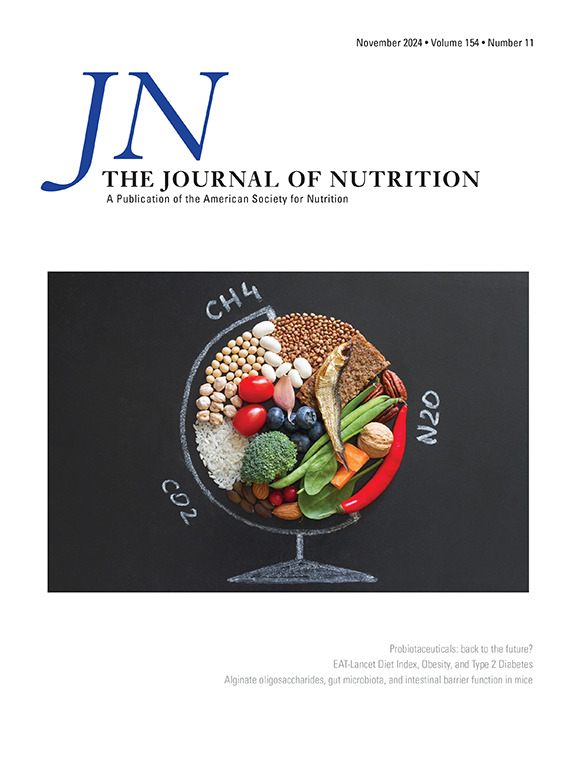炎症性饮食模式与乳腺特征之间的关系
IF 3.7
3区 医学
Q2 NUTRITION & DIETETICS
引用次数: 0
摘要
背景:经验性膳食炎症模式评分(EDIP)可衡量膳食调节慢性炎症的能力,它与较高的脂肪率和乳腺癌(BC)风险有关。乳腺密度(MD)是乳腺癌的一个重要风险因素:我们研究了EDIP与乳房X线摄影特征之间的整体关联,并根据绝经状态进行了分层,同时评估了这些关联在多大程度上受脂肪的影响:我们在护士健康研究(NHS)和NHSII中纳入了4145名无BC的参与者。每 4-6 年通过食物频率问卷对累积平均 EDIP 进行一次评估。我们评估了乳腺X光密度(MD)参数(MD百分比、致密区域和非致密区域)和V(灰度变化度量)。MD 参数经过平方根变换。采用多变量调整线性回归模型分析 EDIP 评分与 MD 参数之间的关系。巴伦和肯尼回归法用于评估EDIP与乳腺X线摄影特征之间的关联在多大程度上受体重指数的影响:结果:在多变量调整模型中,EDIP与MD百分比显著成反比(上四分位与下四分位,β = -0.57,95% CI:-0.78 -0.36)。对体重指数(BMI)的额外调整削弱了这种关联(β= -0.15,95% CI:-0.34 -0.03),68%(β= 0.68,20 95% CI:0.54-0.86)通过体重指数进行调解。此外,在调整体重指数和其他协变量后,EDIP 与非致密区呈正相关。致密区与 V 测量值之间没有关联。根据绝经状况进行分层后,结果相似:结论:EDIP得分与MD百分比成反比,与非致密面积成正比,这些关联在很大程度上受体重指数的影响。本文章由计算机程序翻译,如有差异,请以英文原文为准。
Association between Inflammatory Dietary Pattern and Mammographic Features
Background
The empirical dietary inflammation pattern score (EDIP), which measures the ability of the diet to regulate chronic inflammation, is associated with both higher adiposity and breast cancer (BC) risk. Mammographic density (MD) is an important risk factor for BC.
Objective
We examined the associations between EDIP and mammographic features overall and stratified by menopausal status, and assessed the extent to which these associations are mediated by adiposity.
Methods
We included 4145 participants without BC in the Nurses’ Health Study (NHS) and NHSII. Cumulative average EDIP was assessed by food frequency questionnaires every 4–6 y. We assessed MD parameters (percent MD, dense area, and nondense area) and V (measure of grayscale variation). MD parameters were square-root transformed. Multivariable-adjusted linear regression models were used to analyze the associations between EDIP score and MD parameters. Baron and Kenny’s regression method was used to assess the extent to which the associations of EDIP and mammographic traits were mediated by BMI.
Results
In multivariable-adjusted models, EDIP was significantly inversely associated with percent MD [top compared with bottom quartile, β = –0.57; 95% confidence interval (CI): –0.78, –0.36]. Additional adjustment for BMI attenuated the association (β = –0.15; 95% CI: –0.34, 0.03), with 68% (β = 0.68, 20; 95% CI: 0.54, 0.86) mediation via BMI. In addition, EDIP was positively associated with nondense area after adjusting for BMI and other covariates. No associations were observed for dense area and V measure. Results were similar when stratified by menopausal status.
Conclusions
EDIP score was inversely associated with percent MD and positively associated with nondense area, and these associations were largely mediated by BMI.
求助全文
通过发布文献求助,成功后即可免费获取论文全文。
去求助
来源期刊

Journal of Nutrition
医学-营养学
CiteScore
7.60
自引率
4.80%
发文量
260
审稿时长
39 days
期刊介绍:
The Journal of Nutrition (JN/J Nutr) publishes peer-reviewed original research papers covering all aspects of experimental nutrition in humans and other animal species; special articles such as reviews and biographies of prominent nutrition scientists; and issues, opinions, and commentaries on controversial issues in nutrition. Supplements are frequently published to provide extended discussion of topics of special interest.
 求助内容:
求助内容: 应助结果提醒方式:
应助结果提醒方式:


